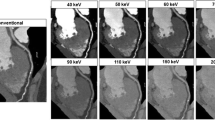Abstract
Digital flat-panel-based volume CT (VCT) represents a unique design capable of ultra-high spatial resolution, direct volumetric imaging, and dynamic CT scanning. This innovation, when fully developed, has the promise of opening a unique window on human anatomy and physiology. For example, the volumetric coverage offered by this technology enables us to observe the perfusion of an entire organ, such as the brain, liver, or kidney, tomographically (e.g., after a transplant or ischemic event). By virtue of its higher resolution, one can directly visualize the trabecular structure of bone. This paper describes the basic design architecture of VCT. Three key technical challenges, viz., scatter correction, dynamic range extension, and temporal resolution improvement, must be addressed for successful implementation of a VCT scanner. How these issues are solved in a VCT prototype and the modifications necessary to enable ultra-high resolution volumetric scanning are described. The fundamental principles of scatter correction and dose reduction are illustrated with the help of an actual prototype. The image quality metrics of this prototype are characterized and compared with a multi-detector CT (MDCT).

















Similar content being viewed by others
References
Popescu S, Stierstorfer K, Flohr T, Suess C, Grasruck M (2005) Design and evaluation of a prototype volume CT scanner. Proc of SPIE 5745:600–608
Ross WR, Dawn C, Fitzgerald P, Basu SK, Beaver R, Cody D (2004) Performance and pre-clinical results from a flat-panel-based volumetric CT system. Proc of RSNA 2004:SSG18–02
Grasruck M, Suess Ch, Stierstorfer K, Popescu S, Flohr T (2005) Evaluation of image quality and dose on a flat-panel CT-scanner. Proc of SPIE 5745:179–188
Roos PG et al (2004) Multiple gain ranging readout method to extend the dynamic range of amorphous silicon flat panel imagers. Proc of SPIE 5368:139–149
Ramachandran GN, Lakshminarayanan AV (1971) Three dimensional reconstructions from radiographs and electron micrographs: application of convolution instead of Fourier transform. Proc Nat Acad Sci 68:2236–2240
Feldkamp LA, Davis LC, Kress JW (1984) Practical cone-beam algorithm. J Opt Soc Am 1(6):612–619
Wiegert J, Bertram M, Schaefer D, Conrads N, Timmer J, Aach T, Rose G (2004) Soft-tissue contrast resolution within the head of human cadaver by means of flat-detector-based cone-beam CT. Proc of SPIE 5368:67–78
Gupta R, Bartling SH, Basu SK, Ross WR, Becker H, Pfoh A, Brady T, Curtin HD (2004) Experimental flat-panel high-spatial-resolution volume CT of the temporal bone. Am J Neuroradiol 25(8):1417–1424
Bartling SH (2002) Experimental results: Volume-CT (VCT) could overcome CT limitations in cochlea implant imaging. J Neuroradiol 29:175
Rodt T, Bartling SH, Gupta R, Pfoh A, Weber BP, Becker H (2002) Optimization of temporal bone CT and 3D-imaging: An experimental approach. Comput Aided Surg 7(2):107–126
Bartling SH, Shukla V, Becker H, Brady TJ, Hayman A, Gupta R (2005) High-resolution flat-panel volume-CT of temporal bone. Part 1: axial preoperative anatomy. J Comput Assist Tomogr 29(3):420–423
Bartling SH, Shukla V, Becker H, Brady TJ, Hayman A, Gupta R (2005) High-resolution computed tomography of temporal bone. Part II: Coronal preoperative anatomy. J Comput Assist Tomogr 29(4):566–569
Bartling S, Rodt T, Gupta R, Weber BP, Nain D, Kikinis R, Pfoh A, Becker H (2002) Experimentelle Untersuchung einer neuen CT Technologie in der Felsenbeindiagnostik. Röfo Fortschr Geb Röntgenstr Neuen Bildgeb Verfahr 174(Suppl. 1):249
Obert M, Ahlemeyer B, Baumgart-Vogt E, Traupe H (2005) Flat-panel volumetric computed tomography: a new method for visualizing fine bone detail in living mice. J Comput Assist Tomogr 29(4):560–565
Brix G, Nagel HD, Stamm G, Veit R, Lechel U, Griebel J, Galanski M (2005) Radiation exposure in multi-slice versus single-slice spiral CT: results of a nationwide survey. Eur Radiol 13(8):1979–1979
Nikolaou K, Flohr T, Stierstorfer K, Becker CR, Reiser MF (2005) Flat panel computed tomography of human ex vivo heart and bone specimens: initial experience. Eur Radiol 15(2):329–333 Feb
Acknowledgements
The authors wish to thank G. Roos, J. Pavkowich, and R. Colbeth at Varian Medical Systems, Inc. (Mountain View, CA) for their collaboration and contribution to this work.
Author information
Authors and Affiliations
Corresponding author
Rights and permissions
About this article
Cite this article
Gupta, R., Grasruck, M., Suess, C. et al. Ultra-high resolution flat-panel volume CT: fundamental principles, design architecture, and system characterization. Eur Radiol 16, 1191–1205 (2006). https://doi.org/10.1007/s00330-006-0156-y
Received:
Revised:
Accepted:
Published:
Issue Date:
DOI: https://doi.org/10.1007/s00330-006-0156-y




